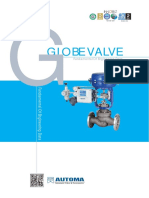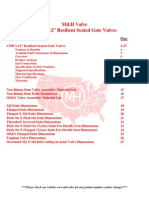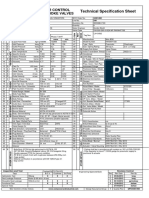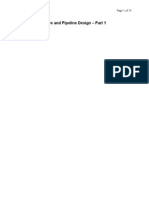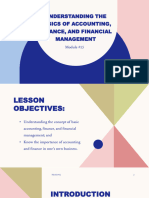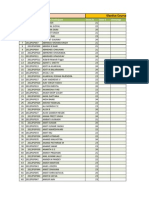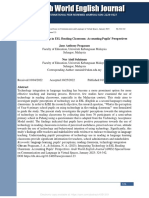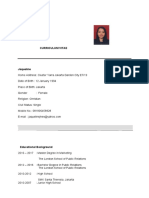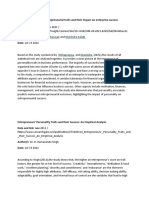Valve Selection Guide
Valve Selection Guide
Uploaded by
rajeshn1Copyright:
Available Formats
Valve Selection Guide
Valve Selection Guide
Uploaded by
rajeshn1Original Description:
Copyright
Available Formats
Share this document
Did you find this document useful?
Is this content inappropriate?
Copyright:
Available Formats
Valve Selection Guide
Valve Selection Guide
Uploaded by
rajeshn1Copyright:
Available Formats
Valve Selection Guide
Valve Terms
Selecting Your Valve
Valve Types
Valve Terms
Breaking Pressure:
The minimum pressure required to produce flow
through a valve.
Duty Cycle:
100% duty cycle is defined as continuous operation
without any damage occurring. For intermittent duty
cycle (<100%), alternate energized and de-energized
state at regular intervals to allow the valve to
completely cool down to room temperature.
F = active concentration / total concentration
Flow Patterns:
A diagram showing how flow can be directed using a
particular valve. (See the Flow Patterns box below for
further explanation.)
Normally Closed:
Valve stays closed in de-energized state; opens when
energized.
Normally Open:
Valve stays open in de-energized state; closes when
energized.
Pressure Differential or Pressure Drop:
The difference between the inlet and the outlet
pressure through a valve. The outlet pressure is lower
than the inlet pressure due to the restriction caused by
the valve.
Three-Way Valve:
Has three ports. Depending on the particular valve, all
three ports may be open, two ports may be open, or
all ports may be closed.
Two-Way Valve:
Has a single inlet port and a single outlet port.
Go to Top
Selecting your Valve
1.
Choose a valve type depending on your application. Our manual
valve selection includes ball, check, diaphragm, elliptic, metering,
needle, pinch, plug, pressure relief, and stopcock valves. Our actuated
valve selection includes electrically actuated ball, elliptic, pinch,
proportioning, and general-purpose solenoid valves.
2.
Consider your fluid type (liquid or gas) and its characteristics
to determine compatible valve materials. Teflon withstands many
harsh or corrosive chemicals. For safety reasons, always use metal
valves for pressurized gases.
3.
Determine the temperature, pressure, and flow rate under
which your valve will be operating. In general, metal valves
withstand higher temperatures and pressures than plastic valves.
4.
For solenoid valves, consider response time and length of time
valve will be energized. Continuous (100%) duty solenoid valves
are best for frequent on/off cycling. Choose normally closed or
normally open depending on the state the valve will be in most often.
5.
Consider your maintenance requirements. Ball valves resist
plugging and are easiest to service.
Go to Top
Valve Types
Angle-Seat Valves:
Utilize an ultra-compact actuator to move a piston
back and forth within the valve body. On/off control
and continuous control designs are available for gases,
steam, and liquids. The construction of the body allows
extremely high flow rates, particularly in comparison to
conventional globe valves.
Ball Valves:
Designed primarily for on/off service. These valves
contain a ball with a hole through it. A handle or
electric actuator rotates the ball 90, turning the flow
on or off. Use plastic ball valves for liquid applications
only.
Butterfly Valves:
Designed primarily for on/off service. These valves
have low pressure drops and are self-sealing so they
dont require an additonal flange gasket for
installation. For pipe sizes ranging from 1.5" to 12" dia.
Check Valves:
Self-actuated valves designed to prevent fluid from
flowing backward into your system. Flow forces a ball
or disk in one direction to open the valve; when flow
stops, the ball or disk seats to close the valve.
Diaphragm Valves:
Use a flexible diaphragm to shut off flowcenter of the
diaphragm is pushed down into a seat. Use these
valves for fluids that are dirty or have a high
particulate content.
Elliptic Valves:
Similar to ball valves except elliptic valves use an
elliptic O-ring to seal the cylinder during rotation. The
seal design makes these valves ideal for vacuum
applications.
Manifold Valves:
Have one common port to two or more additional
ports. For mixing, use the common port as the outlet;
for distributing, use the common port as the inlet.
Metering Valves:
Multi-turn valves designed to regulate the flow of fluid.
These valves generally have low flow rates and high
pressure differentials.
Needle Valves:
Feature the most accurate flow control among the
valves we offer. They are an excellent choice for
precise metering of liquids or gases.
Pinch Valves:
Use solenoid to squeeze shut a piece of tubing. Fluid
contacts only the tubingideal for your high-purity
fluid applications.
Plug Valves:
Used primarily for on/off service. Controls flow using a
plug with a hole through it. Plugs can be made of rigid
materials such as Teflon, making them ideal for highpurity applications.
Pressure Valves:
Designed to control or limit pressurenot flowin a
system. These self-actuating valves will either open a
relief port or bypass the fluid when a preset limit is
reached.
Proportioning Valves:
Designed to produce variable flow rates. Valves open
and close in proportion to the signal from your
controller.
Sample Valves:
Special three-way valve designed to tap off a portion of
the main flow for sampling purposes.
Sanitary Valves:
Feature Tri-Clamp connections and 316 stainless steel
body construction for sanitary and high purity
applications.
Solenoid Valves (Direct Lift):
Use a plunger that is actuated to open or close the
fluid path. These valves usually have low flow rates
and high differential pressure drops. They generally
have quicker response time than pilot-operated valves.
Solenoid Valves (Pilot-Operated):
Utilize pressure created by air or liquids for actuation
purposes. These valves are either piston or diaphragm
types and require differential pressure to keep valve
closed. Because they dont have a plunger, they are
usually available in larger orifice sizes than direct lift
valves.
Stopcocks:
Similar to ball valves except stopcocks are much
smaller in size. Primarily used in the laboratory for
on/off control of flow or as a crude regulation of flow
rate.
Go to top
You might also like
- PIIMA - Presidential School Presentation (26 May - Tashkent - Edu Track)Document11 pagesPIIMA - Presidential School Presentation (26 May - Tashkent - Edu Track)johndavsg8022No ratings yet
- Flange Type Pig SignallerDocument1 pageFlange Type Pig SignallerPrajwal ShettyNo ratings yet
- KSBB-BS Breather Valve Data SheetDocument2 pagesKSBB-BS Breather Valve Data Sheetfathonix0% (1)
- Valve Types and ApplicationsDocument82 pagesValve Types and Applicationsrajeshn1No ratings yet
- Basics of Valves Interview Questions & Answers: Directional Control ValveDocument7 pagesBasics of Valves Interview Questions & Answers: Directional Control ValveJêmš NavikNo ratings yet
- Valve Material SelectionDocument8 pagesValve Material Selectionerovho100% (1)
- Valve Seat Selection GuideDocument4 pagesValve Seat Selection Guideim4uim4uim4uNo ratings yet
- Valve Seat Material GuideDocument1 pageValve Seat Material GuideAndresNo ratings yet
- Valve Selection Guide: - ContentsDocument12 pagesValve Selection Guide: - ContentsAnonymous R23prjoKnoNo ratings yet
- Specification For ValvesDocument24 pagesSpecification For ValvesMehdi NouriNo ratings yet
- Process Valv HandbookDocument14 pagesProcess Valv Handbookdenim89100% (2)
- Ball Valve SeatDocument4 pagesBall Valve SeatRobin HillsonNo ratings yet
- Valve Seat Seal Selection GuideDocument2 pagesValve Seat Seal Selection Guideecovarrubias1No ratings yet
- FCX3 Trunnion Ball ValvesDocument32 pagesFCX3 Trunnion Ball Valveshamr01No ratings yet
- QuillsDocument4 pagesQuillsajostosNo ratings yet
- R - 1776 - Check Valves Side Mounted Extraction Check ValveDocument4 pagesR - 1776 - Check Valves Side Mounted Extraction Check ValvedharmendrabholeNo ratings yet
- Datasheet For Strainer.Document7 pagesDatasheet For Strainer.venka07No ratings yet
- DIB-vs-DBB BALL VALVE PDFDocument1 pageDIB-vs-DBB BALL VALVE PDFDidit SusantoNo ratings yet
- MSA Ball Valves PDFDocument24 pagesMSA Ball Valves PDFLuka Borna100% (1)
- FlowTek Ball Valve DesignDocument0 pagesFlowTek Ball Valve DesignGohilakrishnan ThiagarajanNo ratings yet
- Float Board Level GaugeDocument6 pagesFloat Board Level GaugeanaismariaNo ratings yet
- Globe Valve: Fundamental of Engineering DataDocument16 pagesGlobe Valve: Fundamental of Engineering Datarieza_fNo ratings yet
- Bolting Selection Guide For Bolting MaterialDocument5 pagesBolting Selection Guide For Bolting Materialthuyenquyen_vtNo ratings yet
- Ball Valve Catalogue-2Document12 pagesBall Valve Catalogue-2tndeshmukhNo ratings yet
- Gate ValveDocument27 pagesGate ValveYogesh Kumar Bhatnagar0% (1)
- Auto Drain 70APADH4000Document3 pagesAuto Drain 70APADH4000thomasoburNo ratings yet
- Valves 101: Gobind KhianiDocument56 pagesValves 101: Gobind Khianikongara_inst1118No ratings yet
- STRAINERDocument25 pagesSTRAINERcadhoaNo ratings yet
- PIGGING General BrochureDocument4 pagesPIGGING General BrochureGohilakrishnan ThiagarajanNo ratings yet
- Ball Valve TJ (21 Sep 16)Document24 pagesBall Valve TJ (21 Sep 16)TeukuJoharNo ratings yet
- VBO - Triple Offset Butterfly ValveDocument14 pagesVBO - Triple Offset Butterfly ValveFabio Peres de Lima100% (1)
- Sample Coolers, Sample Cooler, Manufacturer, Supplier, Pune, IndiaDocument3 pagesSample Coolers, Sample Cooler, Manufacturer, Supplier, Pune, IndiaBehzad Totakhaneh BonabNo ratings yet
- Butterfly ValveDocument6 pagesButterfly ValveRomisamomNo ratings yet
- Actuated Ball Valve 357 D - BDKDocument5 pagesActuated Ball Valve 357 D - BDKfarhanakhtar ansariNo ratings yet
- Globe Valve Bs 1873 and Api 602: ASME B16.10Document7 pagesGlobe Valve Bs 1873 and Api 602: ASME B16.10swapnil PATILNo ratings yet
- Actuator DatasheetDocument1 pageActuator DatasheetKo Aung KoNo ratings yet
- Ball Valve Standard DesignDocument9 pagesBall Valve Standard DesignAbdullah Fahmi100% (1)
- Technical Specifications Valve Actuators ScopeDocument6 pagesTechnical Specifications Valve Actuators ScopeBilalPervez100% (1)
- Pipe Wall Thickness Sample CalculationDocument1 pagePipe Wall Thickness Sample CalculationjkahamedNo ratings yet
- Sa 980 P 11434 Cs Swing Check Valve Rev. t02Document3 pagesSa 980 P 11434 Cs Swing Check Valve Rev. t02altipatlar100% (1)
- Globe Valve General Installation Operation & Maintenance ManualDocument5 pagesGlobe Valve General Installation Operation & Maintenance ManualViba Fluid ControlNo ratings yet
- IVGE Butterfly ValveDocument2 pagesIVGE Butterfly ValvejprakashbandaruNo ratings yet
- Valves Reference PDFDocument35 pagesValves Reference PDFJulio RodriguezNo ratings yet
- Datasheets For Bucket Type StrainerDocument2 pagesDatasheets For Bucket Type StrainerbecpavanNo ratings yet
- API Standards For Heat Transfer Equipments, Pumps Ad TanksDocument3 pagesAPI Standards For Heat Transfer Equipments, Pumps Ad TanksSrihari KodimelaNo ratings yet
- WPI-KE-1104-SP141-QM5433 (Datasheet)Document4 pagesWPI-KE-1104-SP141-QM5433 (Datasheet)Jèfrì PìnémNo ratings yet
- Bypass 06.O.Selzer - IMI-CCI-Impact-of-ACC-on-TBS-Desup-Noise-VibrationDocument56 pagesBypass 06.O.Selzer - IMI-CCI-Impact-of-ACC-on-TBS-Desup-Noise-VibrationChirag SabalparaNo ratings yet
- Deluge Valve Model-H2: HD Fire Protect Pvt. Ltd. (Cast Steel) Technical DataDocument16 pagesDeluge Valve Model-H2: HD Fire Protect Pvt. Ltd. (Cast Steel) Technical DataNethajiNo ratings yet
- Valve Material TypesDocument3 pagesValve Material TypesimanadbNo ratings yet
- Catalogue-Of-Valves MSADocument52 pagesCatalogue-Of-Valves MSAJenn LozNo ratings yet
- L&T Ball ValveDocument12 pagesL&T Ball ValvecdsenthilNo ratings yet
- Valve and Pipeline Design Notes - Part 1Document29 pagesValve and Pipeline Design Notes - Part 1vikky123100% (1)
- ValveDocument66 pagesValveUmar Draz100% (1)
- Valve SelectionDocument3 pagesValve SelectionFajar Amin WahyullahNo ratings yet
- Valves: Presented by D.Nagababu (Get-Pp)Document54 pagesValves: Presented by D.Nagababu (Get-Pp)SatishSathyamevaJayathe100% (1)
- Hydraulic Valve and Why Do You Need ItDocument15 pagesHydraulic Valve and Why Do You Need ItDebasish BhattacharjeeNo ratings yet
- Types of Valves (2017-AE-20)Document7 pagesTypes of Valves (2017-AE-20)Shahzad AliNo ratings yet
- Control ValveDocument37 pagesControl Valvevipin12krishnan100% (3)
- Presented By: Merry Ann M. Cabral BSME-421Document36 pagesPresented By: Merry Ann M. Cabral BSME-421Marlon Evangelista100% (1)
- Instrument 5 PDFDocument11 pagesInstrument 5 PDFAli AdnanNo ratings yet
- Types of Valves in Piping: Types of Valves - Tables to estimate man hours of assemblyFrom EverandTypes of Valves in Piping: Types of Valves - Tables to estimate man hours of assemblyNo ratings yet
- AMERONDocument343 pagesAMERONrajeshn1100% (1)
- 0625 - w06 - Ms - 1 Chemistry Igcse Winter 2006Document2 pages0625 - w06 - Ms - 1 Chemistry Igcse Winter 2006rajeshn1No ratings yet
- 0625 w08 Ms 1Document2 pages0625 w08 Ms 1Hubbak KhanNo ratings yet
- Acids and Bases IGCSE ChemistryDocument12 pagesAcids and Bases IGCSE Chemistryrajeshn1No ratings yet
- Biology Notes For IGCSEDocument54 pagesBiology Notes For IGCSErajeshn186% (37)
- Checklist ChemDocument46 pagesChecklist Chemadele30No ratings yet
- Access FittingsDocument2 pagesAccess Fittingsrajeshn1No ratings yet
- Data Sheet For Latrolets - 903Document6 pagesData Sheet For Latrolets - 903rajeshn1No ratings yet
- Circuit DiagramDocument5 pagesCircuit Diagramaji.istantorambonoNo ratings yet
- EQUIPMENTS in ICCUDocument5 pagesEQUIPMENTS in ICCUrhyanne100% (1)
- Understanding The Basics of Accounting, Finance, and Financial ManagementDocument17 pagesUnderstanding The Basics of Accounting, Finance, and Financial Managementfrickzy ibanezNo ratings yet
- Test Method: Document No. UT/Lab/TM/W/021 Issue Date 01-04-2009Document3 pagesTest Method: Document No. UT/Lab/TM/W/021 Issue Date 01-04-2009Yogesh DhekaleNo ratings yet
- DME Lecture NotesDocument20 pagesDME Lecture NotesMuhammad HaziqNo ratings yet
- Inspection and Quality Control in Production ManagementDocument4 pagesInspection and Quality Control in Production ManagementSameer KhanNo ratings yet
- Sys A CDocument40 pagesSys A Cdnageshm4n244No ratings yet
- PGP Batch 2012-14Document289 pagesPGP Batch 2012-14Sandeep ChowdhuryNo ratings yet
- Integrating Technology in ESL Reading Classroom, Accounting Pupils' PerspectivesDocument19 pagesIntegrating Technology in ESL Reading Classroom, Accounting Pupils' PerspectivesNOOR IYLIA BINTI ABU BAKAR MoeNo ratings yet
- Diameter Routing: Use Case GuideDocument14 pagesDiameter Routing: Use Case Guidemonel_24671100% (1)
- NATO Chicago Economic ImpactDocument15 pagesNATO Chicago Economic ImpactPATRIOTSKULLZNo ratings yet
- Memorandum of UnderstandingDocument5 pagesMemorandum of UnderstandingJethro Virrey PancubitNo ratings yet
- Tigers: An Endangered SpeciesDocument12 pagesTigers: An Endangered SpeciesJane TranNo ratings yet
- Geological Survey of Great Britain - L The Country Around Holmfirth and GlossopDocument233 pagesGeological Survey of Great Britain - L The Country Around Holmfirth and GlossopCraig BurtonNo ratings yet
- Shaw Channel LineupDocument6 pagesShaw Channel LineupzhukeeNo ratings yet
- Simple Harmonic Motion (6 Hours)Document87 pagesSimple Harmonic Motion (6 Hours)aNo ratings yet
- Cardiac Tamponade: Stevie Newmark, Immad HussainiDocument28 pagesCardiac Tamponade: Stevie Newmark, Immad HussainiImmad.HNo ratings yet
- CV JaquelineDocument5 pagesCV JaquelineZulkarnain Febri Wicaksono, S.H.No ratings yet
- 7 Soliton PDFDocument8 pages7 Soliton PDFAnonymous K9F6Z7LwuNo ratings yet
- Ambuj Gupta : I. D. No. 46671 ObjectiveDocument1 pageAmbuj Gupta : I. D. No. 46671 ObjectiveAmbujNo ratings yet
- Methods For Describing Sets of DataDocument114 pagesMethods For Describing Sets of DataJuan FranNo ratings yet
- Multiple Emulsion ReviewDocument11 pagesMultiple Emulsion ReviewverygoodbrotherNo ratings yet
- Supply Chain MetricsDocument9 pagesSupply Chain MetricsjosefnuduNo ratings yet
- Mica Ella Resume&ApplicationLetterDocument3 pagesMica Ella Resume&ApplicationLettermicamanaois1217No ratings yet
- Medplus Ltd. (A), (B), (C) - UnlockedDocument7 pagesMedplus Ltd. (A), (B), (C) - UnlockedHimanshu BhanarkarNo ratings yet
- 1984 Louisiana Loess Fieldtrip GuidebookDocument139 pages1984 Louisiana Loess Fieldtrip Guidebooketchplain100% (2)
- AEG JSA 107 Angle GrinderDocument3 pagesAEG JSA 107 Angle GrinderSai PrasathNo ratings yet
- Sthitaprajnya Pattanayak Munindra KakatiDocument2 pagesSthitaprajnya Pattanayak Munindra KakatiKyla Mae LangitNo ratings yet





















